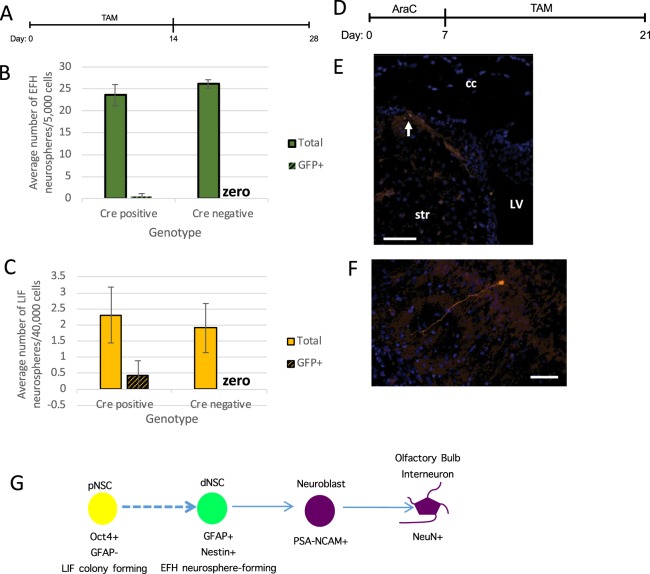Figure 5.
Oct4 expressing, primitive NSC contribution to the neural lineage. (a) Schematic of the experimental paradigm. (b) Neurosphere assay performed from Oct4CreERT2;tdTomatofl mice that had been fed tamoxifen assayed for dNSCs derived from pNSCs (Cre positive) against controls (Cre negative). (c) The number of pNSC derived colonies labeled assessed in Oct4CreERT2;tdTomatofl mice (Cre positive) versus controls (Cre negative). (d) Schematic of the experimental paradigm. (e) Rare tdTomato+, Oct4 expressing cells are located in the dorsolateral corner of the lateral ventricles during repopulation following ablation with AraC of the dNSCs and progeny. Scalebar = 100 µm. LV = lateral ventricle, str = striatum, cc = corpus callosum. (f) tdTomato+ neurons located in the olfactory bulb derived from Oct4 expressing pNSCs. Scalebar = 100 µm. (g) Proposed lineage where dNSC in the adult brain SVZ are GFAP expressing cells that form clonally derived neurospheres in the presence of growth factors (EGF and FGF and heparin)(EFH). These dNSC proliferate to give rise to migrating neuroblasts on the rostral migratory stream. Neuroblasts migrate to the olfactory bulb where they differentiate into olfactory bulb interneurons. Rare GFAP negative, Oct4 positive, LIF responsive, colony-forming cell are found in the periventricular region of the adult brain. These pNSCs are found during development, as early as E5.5, and persist into adulthood.

